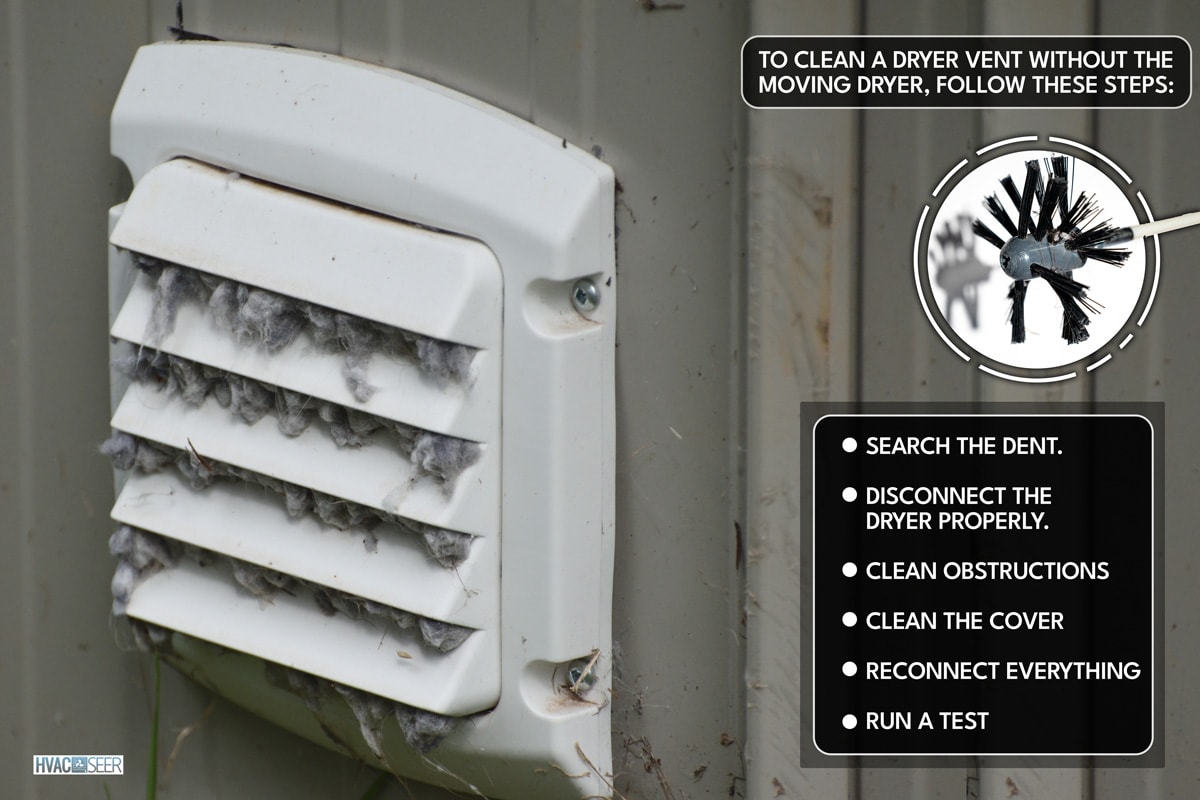Your dryer requires a way to eliminate all the damp air since it employs motion and heated air to remove moisture from your laundry. Your dryer vent is an air duct that runs from the dryer into the wall and transports heated air outside. So how do you clean this out without moving the dryer? We've done the research and come up with concrete responses to your inquiries.
Follow these steps:
- Search the dent.
- Disconnect the dryer properly.
- Clean obstructions
- Clean the cover
- Reconnect everything
- Run a test
Lint buildup in a dryer vent poses a fire risk and lowers the appliance's efficiency. Learn how to clean your vent and maintain it by reading about it.

Cleaning Dryer Vent
A dirty dryer vent is one of the biggest risks for house fires. Additionally, it will waste your time, effort, and money, even if clogged dryer ducts don't immediately result in property damage. The steps for cleaning your dryer vent are listed below.

Find the Vent
Because they frequently protrude from the dryer itself, dryer vents are simple to locate. Keep an eye out for a lengthy silver or white hose coming from the dryer's back.
Follow the vent pipe once you've found it at the back of the dryer to where it leaves the house.
One or more circular brackets that go over the top of the vent hose and are tightened over the transition vent pipe that leads outside should be used to secure it in place.
Disconnect
The clamps holding the dryer vent hose to the wall should be loosened and unscrewed using a screwdriver.

To avoid accidentally injuring the vent when you remove the clamps, they should be able to move freely along the flexible dryer vent line. Remove the power cord from the wall outlet and unplug the device. Natural gas-powered dryer owners need to exercise additional caution.
Clean Obstructions
Use dryer vent cleaning brushes to eliminate leftover dust, filth, hair, lint, or debris. These instruments typically comprise a multi-sided brush and an extendable telescopic pole, which enables the brush to pass along the entire vent hose.
Some of these goods can be used with a drill, causing the brush to spin quickly while traveling through the vent hose to scrub away dirt that has become caught on.
See this cleaning brush on Amazon.
Clean The Cover
The dryer's vent lid should be thoroughly cleaned to prevent leftover debris from accumulating inside the dryer and causing a clog that raises the fire risk.
Additionally, it could lead to an overheated dryer that damages its delicate internal components.
Remove the vent cover with a screwdriver, then vacuum away any leftover dirt. Utilizing a microfiber cloth and hot, soapy water, clean the vent cover.
Before re-attaching the cover to the dryer, dry it with a second microfiber towel or let it air dry.
See this microfiber cloth on Amazon.
Reconnect
Return inside, plug the dryer back in, and run the empty machine on the air-dry setting once the vent appears clear.
Before stopping the dryer and replacing the outside vent cover, check if the vent is blowing air and if there is any remaining lint outside.
Test
Make sure there are no ventilation system leaks by thoroughly testing the dryer.
Double-check that the hose is reconnected correctly to prevent venting the dryer exhaust into the house after cleaning and replacing the vent line.
This is crucial for gas dryers since improperly installed vents might result in carbon monoxide buildup.
How Can I Tell If The Vent In My Dryer Is Blocked?
High energy expenses, fire, and ineffective drying are all risks associated with clogged dryer vents.
It would be absurd not to mention the higher risk of fire from an unexpected spark from a dryer duct when discussing the increased cost of blocked ducts.
Learn the warning signs of a clogged vent so you can put cleaning it on top of your list of priorities.
To find out if your dryer vent is blocked or requires more work, consider these signs:
- Clothing Dries Too Slowly
- Clothing and Dryer Exterior Are Extremely Hot
- The dryer is emitting a burning odor.
- The buildup of debris and lint around the exterior vent
- Service Required for Dryer
You can use these easy things to check to see if you have a more significant issue or not. The moment has come to call in a trained dryer exhaust technician if these easy techniques fail to locate the problem and you are still experiencing issues. Let's begin immediately.
Distance And Location
In addition to the number of turns the vent hose needs to make to get there, the distance from your laundry room to the outdoor vent is an important consideration.
The dryer hose is more likely to become blocked with lint and dirt the farther it is from the outside vent. Spend some time learning the indicators of a clogged vent.

Drying of Clothes
There is not enough airflow through the dryer to completely dry the clothing inside if the dryer vent is blocked. Your dryer vent needs cleaning if you are diligent about emptying the lint trap after each use.
Your clothing will stay damp for longer if moisture cannot escape while it dries. The clogged lint, debris, and dust attempt to escape and push the humid air back into the dryer.
Hot
A lovely, snug load of laundry should be waiting for you when you open your dryer. It's conceivable that your dryer vent is clogged if, instead, you find that your garments feel hot to the touch.

The blocked lint and your clothing risk igniting and may start a fire when the heat is more intense. This is a clear indication that your dryer vent may be blocked.
Burning Smell
You must act if the burning smell coming from your dryer is noticeable. Before smoke ever starts to develop, we aim to stop this fire hazard. Lint buildup becomes extremely hot, heat is concentrated, and flammable things can catch fire if your dryer vent is blocked.
Get a dryer brush kit and clean the dryer vent/duct that links the dryer to the wall, the lint trap, and the lint trap vent.
Debris And Lint
The dryer vent outside the house is an excellent spot to look for signs that your dryer vent is clogged.
If lint and debris buildup is on or near this exterior vent, you probably require a specialist to examine the venting system and thoroughly clean it.

Service
So you don't remember the last time you or a professional cleaned the dryer vents or had your dryer serviced? So it's time for you to start. However, if you want to ensure no details are missed, it could be time to contact a specialist.
How Can I Remove The Lint From My Front-Loading Dryer?
Learn to remove dryer lint to avoid home fires. Both the lint within your clothes dryer and the lint lodged in the exhaust vent should be cleaned. The dryer cleaning takes about 30 minutes to finish.
Follow these simple steps:
- Get the Lint Screen Clean
- Make the dryer vent ducts clear.
- Take the clamp apart.
- Place the vent brush in.
The drying process is significantly slowed when the lint screen is blocked with grease or residue from dryer sheets because it restricts the airflow. Keep reading to learn more.
Lint Screen
Find the dryer's lint screen; these are often located at the bottom of the opening inside the dryer door. Pull the tab on the screen to remove the filter from the dryer.

Throw away the filter lint, wash the screen in warm, soapy water if it seems waxy or sticky, and then thoroughly dry it. Fabric softener sheets create waxy accumulation so if you use these sheets frequently, wash the lint screen occasionally.
Dryer Vent
Find the dryer's outer exhaust hood if possible. Typically, the exhaust hood is located on the outside wall next to the dryer, so the exterior exhaust hood should now be free of the house siding. With the flashlight, check the aperture for any insects or other pests.
Clamp
Remove the clamp holding the dryer vent line to the wall-mounted exhaust duct and set the hose down after carefully removing it from the duct.
Brush
Put the vent brush inside the wall's vent pipe. To get the lint to exit through the exhaust hood opening, push it through the duct until it does.
Connect the nylon brush to an extension rod for straight duct runs or an extension cable for curved duct runs if the duct runs are extremely long.
In Closing
Determine the location of your dryer vent before cleaning it, and be sure to remove the lint trap filter.
Understanding how to properly clean a dryer vent is essential for safety and cleanliness. You can accomplish this in six easy steps, leaving you with completely dry clothing, cleaner lint screens, and a ton more laundry bliss.
If you find this informative, Check out these related articles:


